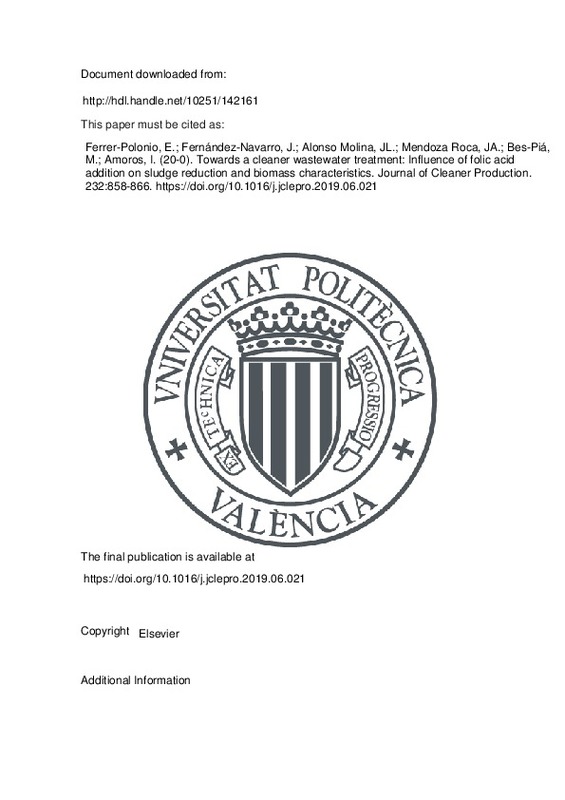JavaScript is disabled for your browser. Some features of this site may not work without it.
Buscar en RiuNet
Listar
Mi cuenta
Estadísticas
Ayuda RiuNet
Admin. UPV
Towards a cleaner wastewater treatment: Influence of folic acid addition on sludge reduction and biomass characteristics
Mostrar el registro sencillo del ítem
Ficheros en el ítem
| dc.contributor.author | Ferrer-Polonio, Eva
|
es_ES |
| dc.contributor.author | Fernández-Navarro, Julián
|
es_ES |
| dc.contributor.author | Alonso Molina, José Luís
|
es_ES |
| dc.contributor.author | Mendoza Roca, José Antonio
|
es_ES |
| dc.contributor.author | Bes-Piá, M.A.
|
es_ES |
| dc.contributor.author | Amoros, Inmaculada
|
es_ES |
| dc.date.accessioned | 2020-05-04T06:28:11Z | |
| dc.date.available | 2020-05-04T06:28:11Z | |
| dc.date.issued | 2019-09-20 | es_ES |
| dc.identifier.issn | 0959-6526 | es_ES |
| dc.identifier.uri | http://hdl.handle.net/10251/142161 | |
| dc.description.abstract | [EN] Reduction of sludge production is one of the most desired goals in the wastewater treatment plants operation. Alternatives like the enhancement of metabolism uncoupling or the increase of endogenous respiration by different chemicals have been reported in the bibliography. In this work, two folic acid concentrations (0.8 and 1.6mg L-1) added to a laboratory sequencing batch reactor were tested in order to assess the effect of this vitamin on the biological treatment. For this purpose, in addition to study sludge reduction and organic matter removal, an exhaustive biomass characterization including soluble microbial products, cellular viability, adenosine triphosphate (ATP), microbial hydrolytic enzymatic activities and bacterial community analysis have been performed. Results indicated that a concentration of 0.8 mg L-1 led to the greatest sludge reduction (44.7%), due to the increase of endogenous respiration. In the reactor with folic acid addition, higher soluble microbial products, enzymatic activities, cellular viability and lower cellular ATP was observed. Regarding the microbial community, folic acid addition did not affect nitrifying bacteria although it did reduce the abundance of denitrifying, increased the amount of filamentous bacteria (Caldilineacaeae and Haliscomenobacter) and enhanced Bacteriodetes and Chloroflexi phyla. A continuous addition of folic acid drove to biomass adaptation that caused a diminution of folic acid activity after 40 days. | es_ES |
| dc.description.sponsorship | This work was supported by the Ministry of Economy and Competitiveness, Spain (grant no. CTM2014-54546-P-AR). | es_ES |
| dc.language | Inglés | es_ES |
| dc.publisher | Elsevier | es_ES |
| dc.relation.ispartof | Journal of Cleaner Production | es_ES |
| dc.rights | Reserva de todos los derechos | es_ES |
| dc.subject | Bacterial community | es_ES |
| dc.subject | Biological wastewater treatment | es_ES |
| dc.subject | Folic acid | es_ES |
| dc.subject | Sequencing batch reactor | es_ES |
| dc.subject | Sludge reduction | es_ES |
| dc.subject.classification | INGENIERIA QUIMICA | es_ES |
| dc.title | Towards a cleaner wastewater treatment: Influence of folic acid addition on sludge reduction and biomass characteristics | es_ES |
| dc.type | Artículo | es_ES |
| dc.identifier.doi | 10.1016/j.jclepro.2019.06.021 | es_ES |
| dc.relation.projectID | info:eu-repo/grantAgreement/MINECO//CTM2014-54546-P/ES/DISMINUCION DEL ENSUCIAMIENTO DE MEMBRANAS DE ULTRAFILTRACION EN BIORREACTORES Y EN TRATAMIENTOS TERCIARIOS MEDIANTE REDUCCION DE SUSTANCIAS POLIMERICAS EXTRACELULARES/ | es_ES |
| dc.rights.accessRights | Abierto | es_ES |
| dc.contributor.affiliation | Universitat Politècnica de València. Departamento de Ingeniería Química y Nuclear - Departament d'Enginyeria Química i Nuclear | es_ES |
| dc.contributor.affiliation | Universitat Politècnica de València. Instituto de Seguridad Industrial, Radiofísica y Medioambiental - Institut de Seguretat Industrial, Radiofísica i Mediambiental | es_ES |
| dc.contributor.affiliation | Universitat Politècnica de València. Instituto Universitario de Ingeniería del Agua y del Medio Ambiente - Institut Universitari d'Enginyeria de l'Aigua i Medi Ambient | es_ES |
| dc.description.bibliographicCitation | Ferrer-Polonio, E.; Fernández-Navarro, J.; Alonso Molina, JL.; Mendoza Roca, JA.; Bes-Piá, M.; Amoros, I. (2019). Towards a cleaner wastewater treatment: Influence of folic acid addition on sludge reduction and biomass characteristics. Journal of Cleaner Production. 232:858-866. https://doi.org/10.1016/j.jclepro.2019.06.021 | es_ES |
| dc.description.accrualMethod | S | es_ES |
| dc.relation.publisherversion | https://doi.org/10.1016/j.jclepro.2019.06.021 | es_ES |
| dc.description.upvformatpinicio | 858 | es_ES |
| dc.description.upvformatpfin | 866 | es_ES |
| dc.type.version | info:eu-repo/semantics/publishedVersion | es_ES |
| dc.description.volume | 232 | es_ES |
| dc.relation.pasarela | S\389155 | es_ES |
| dc.contributor.funder | Ministerio de Economía y Competitividad | es_ES |







![[Cerrado]](/themes/UPV/images/candado.png)

